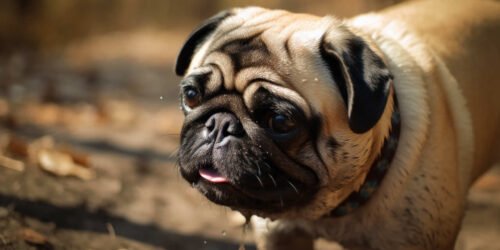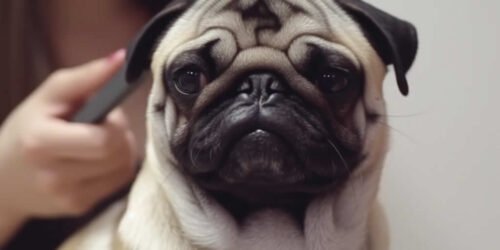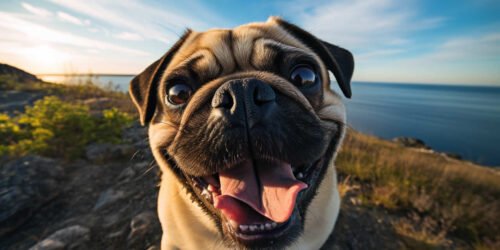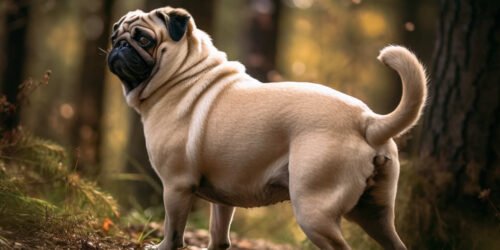Are Bald Patches Common in Older Pugs?
Introduction
Have you noticed your older pug developing unattractive bald patches? As a dog owner who’s seen this, I can empathise with the problem and let me tell you, it’s more common than you may think.
Through comprehensive research and expert insights, this article will provide clarity on possible causes and offer practical solutions to manage these pesky bald spots. Ready to bring back that shiny coat for your lovable pug? Let’s dive in!
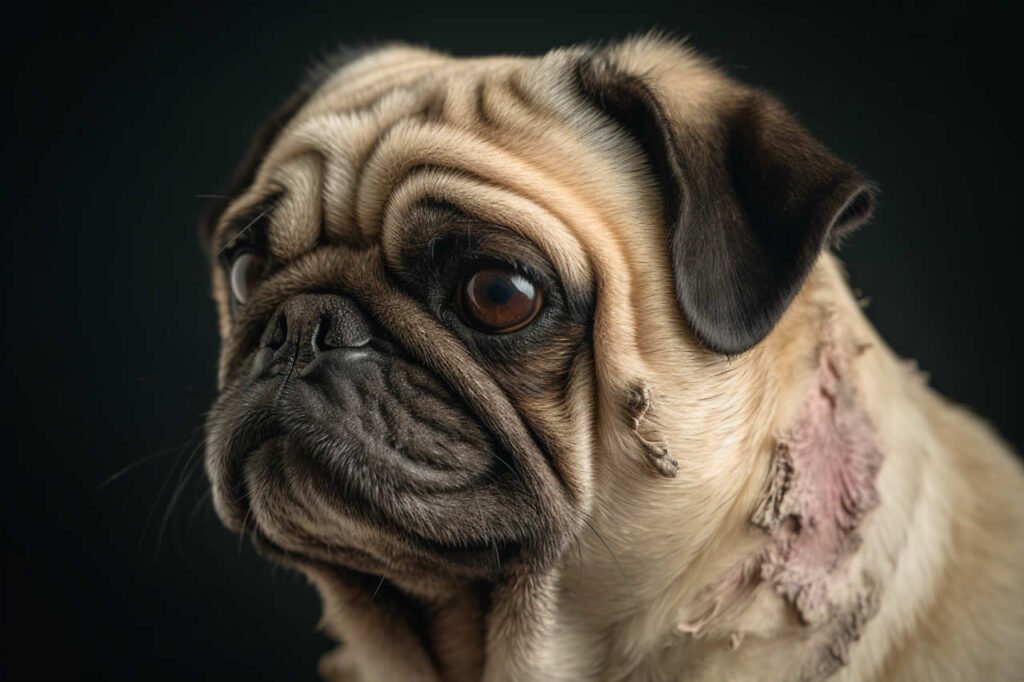
Table of Contents
- Introduction
- Common Causes of Bald Patches in Older Pugs
- Managing and Treating Bald Patches in Older Pugs
- Conclusion
Common Causes of Bald Patches in Older Pugs
Bald patches in older pugs can be caused by a variety of factors, including parasites, thyroid imbalance, stress and anxiety, allergies, Cushing’s disease, infection, and alopecia.
Parasites
As a seasoned pug owner, I’ve seen my fair share of bald patches on my beloved dogs. One common culprit can be parasites – an uncomfortable issue for any pet. This isn’t just limited to fleas and ticks.
Mites, the microscopic pests causing conditions like mange, often lead to hair loss in pugs. The good news? Parasite-induced baldness usually clears up once the infestation is under control.
A visit to your vet will help identify these unwelcome guests and prescribe suitable treatments like anti-parasite medications or special shampoos for your furry friend.
Thyroid imbalance
As a fellow pug parent, I’ve come to know our beloved pets may encounter thyroid imbalances as they age. This endocrine disorder can be one of the chief culprits behind “pug bald patches”.
Hypothyroidism – an underactive thyroid gland – is especially common in older pugs. It significantly slows down their metabolism, resulting in excessive hair loss or development of bald spots.
But don’t fret! You’ll usually notice other accompanying symptoms such as weight gain, lethargy and a slower heart rate if your pet has hypothyroidism. It’s important to solicit professional help from your vet who can confirm this through blood tests.
Thankfully, the condition is manageable with daily medications helping regain fur growth over time while also improving overall health.
Stress & anxiety
It’s surprising, but stress and anxiety can lead to bald patches in older pugs. Just like us humans, dogs also suffer from emotional distress that could result in noticeable physical changes.
When a pug feels stressed or anxious for prolonged periods, it may start shedding excessively. That’s because the hormones released during stressful situations can disrupt normal hair growth cycle.
Trying to pinpoint the root cause of your pug’s stress is crucial for managing this issue. It might be due to changes in their environment, separation anxiety or even boredom. Increasing playtime and providing them with plenty of love and comfort can help alleviate this problem.
In more severe cases though, consult a vet who might recommend medications or behavioural therapy techniques for your furry friend’s peace of mind – effectively giving those pesky pug bald patches a rest!
Allergies
One thing that pug owners need to be aware of when it comes to bald patches in older pugs is the potential role of allergies. Just like humans, dogs can develop allergies as they get older, and this can lead to hair loss or thinning patches on their skin.
Allergens such as pollen, dust mites, certain foods, or even specific materials like wool can trigger an allergic reaction in your furry friend. If you start noticing bald patches on your pug’s body, it might be worth exploring whether allergies could be the cause.
Consulting with a veterinarian will help you identify the allergen and determine the best course of action to manage your pug’s allergy symptoms and promote healthy regrowth of their fur.
Cushing’s disease
One common cause of bald patches in older pugs is Cushing’s disease. This condition occurs when the adrenal glands produce too much cortisol, a hormone that affects the immune system and hair growth.
Excess cortisol can lead to thinning hair or even complete baldness in certain areas of a pug’s body. If your furry friend is experiencing bald patches, it’s important to consult with your veterinarian.
They may recommend treatment options such as medication or dietary changes to help manage this condition and promote hair regrowth. With proper care and attention, you can help alleviate the effects of Cushing’s disease on your pug’s coat and overall well-being.
Infection
I have noticed that in some older pugs, bald patches can be caused by infections. These infections can range from bacterial to fungal and can lead to hair loss in specific areas of their body.
Infections can occur due to a weakened immune system or poor hygiene practices.
If you notice your pug has a bald patch that looks red, inflamed, or is oozing any kind of fluid, it’s important to take them to the vet as soon as possible. The vet will be able to diagnose if the bald patch is indeed caused by an infection and recommend the appropriate treatment.
Treatment for infections usually involves a course of antibiotics or antifungal medication depending on the type of infection present. It’s crucial to follow through with the entire prescribed treatment even if you start seeing improvement early on, as incomplete treatment can result in recurring infections.
Alopecia
Alopecia, or hair loss, is another common cause of bald patches in older pugs. Although it can be distressing to see your furry friend’s coat thinning out, there are ways to manage and treat this condition.
Alopecia can have various underlying causes, including hormonal imbalances, immune system disorders, or even genetics. It’s essential to consult with a veterinarian to determine the specific cause of the alopecia in your pug.
Once the cause has been identified, appropriate treatment options can be explored. This may include prescribed medications such as corticosteroids or other immunosuppressive drugs to help suppress any inflammatory response that may be contributing to hair loss.
Additionally, your vet may recommend grooming regimens that promote hair growth and prevent further damage by using gentle brushes and avoiding harsh chemicals. Nutritional changes can also play a role in managing alopecia; certain dietary supplements rich in omega-3 fatty acids or biotin might improve overall coat health for your ageing pug companion.
Managing and Treating Bald Patches in Older Pugs
To help your older pug regain a luscious coat, there are several approaches you can take – from medication and grooming regimens to nutritional changes and supplements.
Medication
As a pug owner, I understand how important it is to find effective solutions for managing and treating bald patches in older pugs. In some cases, medication may be necessary to help address the underlying causes of these bald patches. Here are some medication options that can be helpful:
- Topical Treatments: There are medicated creams and ointments available that can be applied directly to the affected areas on your pug’s skin. These topical treatments can help reduce inflammation and promote hair regrowth.
- Oral Medications: Your veterinarian may prescribe oral medications such as antihistamines or corticosteroids to help manage allergies or reduce inflammation associated with bald patches. These medications can help alleviate itching and promote hair growth.
- Antibiotics: If the bald patches are caused by an infection, your veterinarian may prescribe antibiotics to treat the underlying bacterial or fungal infection. It is important to follow your vet’s instructions for administering these medications to ensure effectiveness.
- Hormone Therapy: In cases where hormonal imbalances, such as thyroid issues or Cushing’s disease, are causing the bald patches, medication may be prescribed to regulate hormone levels and promote hair regrowth.
- Immunosuppressants: In certain cases of autoimmune-related alopecia, immunosuppressive medications may be recommended by your veterinarian. These drugs work by suppressing the overactive immune response that is attacking hair follicles.
Grooming regimens
Taking care of your pug’s grooming needs is crucial to prevent and manage bald patches. Here are some grooming regimens that can help:
- Regular brushing: Brush your pug’s coat at least once a week to remove loose hair and prevent matting. Use a soft-bristle brush or a rubber grooming mitt to gently comb through their fur.
- Bathing: Pugs have sensitive skin, so bathe them only when necessary using a mild shampoo specifically designed for dogs. Avoid over-bathing, as it can strip the natural oils from their skin.
- Moisturising: Pugs are prone to dry skin, which can contribute to bald patches. Use a moisturising dog conditioner after bathing to keep their skin hydrated and healthy.
- Trimming nails: Overgrown nails can cause discomfort and affect your pug’s gait, leading to bald patches due to excessive licking or scratching. Regularly trim their nails or seek professional help if you’re unsure.
- Ear cleaning: Pugs have folded ears that require regular cleaning. Use a gentle ear cleaner recommended by your veterinarian and wipe the outer folds of their ears with cotton pads or wipes.
- Eye care: susceptible to eye problems due to their prominent eyes, which can lead excessive tearing and rubbing. Regularly clean around their eyes using a damp cloth or eye wipes.
- Dental hygiene: Poor oral health can contribute to overall health issues in pugs, including hair loss. Brush your pug’s teeth regularly with a dog-friendly toothbrush and toothpaste approved by your veterinarian.
Nutritional changes
As a pug owner, I understand how concerning it can be to see your older pug develope bald patches. Fortunately, there are steps you can take to manage and treat these bald spots. One important aspect to consider is making some nutritional changes. Here are some tips:
- Opt for a high-quality dog food: Look for a dog food that is specifically formulated for senior dogs or those with skin issues. These foods often contain ingredients that promote healthy skin and coat.
- Ensure a balanced diet: Make sure your pug’s diet includes a balance of proteins, carbohydrates, fats, vitamins, and minerals. This will provide the necessary nutrients for overall health and hair growth.
- Consider adding supplements: Speak to your veterinarian about adding supplements such as omega-3 fatty acids, biotin, or other hair-supporting nutrients to your pug’s diet. These supplements can help promote hair growth and improve the condition of their skin.
- Avoid common allergens: Some pugs may have food allergies that can contribute to bald patches. Common allergens include beef, chicken, wheat, corn, and soy. If you suspect your pug has food allergies, work with your vet to identify the culprit and adjust their diet accordingly.
- Stay hydrated: Ensuring your pug drinks enough water is vital for overall health, including maintaining healthy skin and coat. Provide fresh water throughout the day and encourage them to drink regularly.
Supplements
Supplements can play a helpful role in managing and treating bald patches in older pugs. Here are some supplements that can promote healthy skin and coat:
- Omega-3 fatty acids: These essential fatty acids support skin health and reduce inflammation, helping to alleviate itching and irritation that may contribute to bald patches.
- Biotin: Biotin is a B-vitamin that aids in the growth of healthy hair, skin, and nails. Supplementing with biotin can help promote regrowth in areas where pugs have experienced hair loss.
- Zinc: Zinc is an important mineral for overall skin health. It assists in wound healing and supports immune function. A zinc supplement may help address potential deficiencies that could contribute to bald patches.
- Vitamin E: Vitamin E is an antioxidant that helps protect cells from damage caused by free radicals. It also promotes healthy skin by reducing itchiness and dryness.
- Probiotics: Probiotics support gut health, which plays a significant role in overall immunity and skin condition. A healthy gut microbiome can reduce inflammation and improve nutrient absorption for healthier skin and coat.
Conclusion
In conclusion, bald patches in older pugs are quite common and can be caused by a variety of factors such as parasites, thyroid imbalance, stress, allergies, Cushing’s disease, infection, or alopecia.
However, the good news is that there are several ways to manage and treat these bald patches including medication, grooming regimens, nutritional changes, and supplements. By being proactive and addressing these issues early on, you can help your older pug maintain a healthy coat for years to come.

